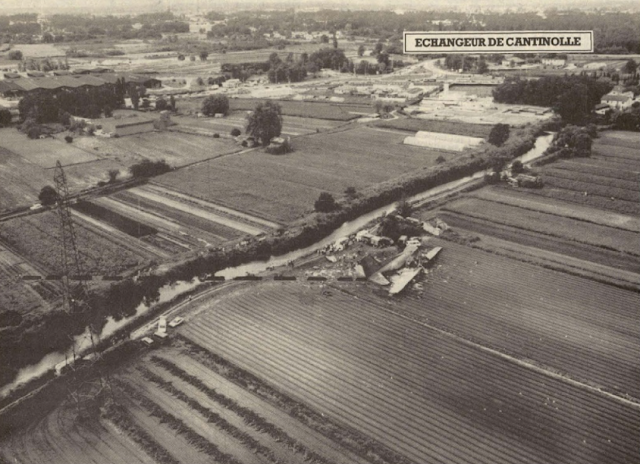It is 11:30 on Saturday July 2nd 1988, deep in the farmlands of Eysines, and the relative silence is broken by the sound of a Transall C-160D military transport aircraft crashing to the ground. Miraculously, the six people on board all survived. What happened?
The aircraft belonged to the West German air force. It had departed earlier that morning from Landsberg, near Munich, and was one of a fleet flying into Mérignac with a view to picking up German paratroopers who had recently completed exercises alongside French counterparts at the Camp de Souge military base in Martignas-sur-Jalle.
 |
| A modern-day German Air Force Transall C-160, like the one involved in the crash. The aircraft type is currently being phased out in France and Germany, and being replaced by the Airbus A400M Atlas. Picture source: Wikipedia. |
Reaching la Gironde, the Transall had entered its approach phase when the pilot realised the left engine had cut out. With the plane virtually gliding and rapidly losing altitude he steered it away from the flight path, and in the hope of avoiding built-up areas pointed westwards towards the fruit- and vegetable-growing plains of Eysines, with a view to conducting an emergency landing.
However, with landing gear now in position and flying just a few metres above the ground, an unexpected and unwanted obstacle appeared: high-voltage power lines. There would be no way of rising above the cables, so the pilot attempted instead to guide the plane underneath. That is when the wheels of the aircraft hit the banks of the “jalle”, the stream that runs through the heart of the Eysines vegetable-growing patches, and the plane twisted and turned over a short distance before breaking up and coming to a sudden halt… at a spot not far from where the Cantinolle terminus of tram line D can now be found.
 |
| Aerial picture credited to Caroline Marmolat (from an Airlec helicopter) which featured in the Monday July 4 1989 issue of Sud Ouest, incorporating a dotted line showing the trajectory of the aircraft, and Eysines-Cantinolle roundabout in the background. Source: Sud Ouest archives. |
 |
| The same area at ground level today, note the jalle over to the left, and power cables towards the right of the picture. |
Four of the six crew members were immediately able to escape from the wreckage, the two others had to be cut free by rescue services. All were transported to Bordeaux’s Pellegrin hospital, where it was soon established that three had come out of the ordeal totally unscathed, while the three others – though initially considered “seriously injured” – ultimately suffered little more than a few broken bones. As early as the next day, they were able to assist investigators with their enquiries. Meanwhile, the 48 paratroopers who were set to return home were no doubt shaken when they heard the news, wondering what might have been had the aircraft being fully loaded when the faulty engine cut out.
A couple of days later, local newspaper Sud Ouest ran an interview with one Pierre-Élie Baron, who was among the first on the scene of the crash: “I saw the plane go by at a very low altitude, just above the treetops. An engine had cut out because the left propeller was no longer turning. There was a loud thud and I knew it had crashed. I jumped on my bike and got to the crash at the same time as the gendarmes who were patrolling the Majolan caves." So it certainly made for a busier afternoon than expected for the gendarmes who had been assigned to the notoriously peaceful Majolan park in Blanquefort…
 |
| Sud Ouest coverage of the accident, including the interview with Pierre-Élie Baron. Photos credited to Caroline Marmolat and Guy Martineriq (?). Source: Sud Ouest archives. |
Monsieur Baron added: “One of the pilots had been ejected. I asked him how many were in the plane and he answered in German. He was totally shaken, poor man! There were guys trapped but none of them were moaning or screaming. It was impressive!"
Vegetable farmer Francis Barrière was also interviewed, he actually owned the plot of land where the plane crashed: “That very morning, I was ploughing just 50 metres away. It's a miracle that there was no one in the fields at that time.”
If things turned out the way they did, much can be attributed to the exemplary work of the emergency services, who were quick on the scene, providing an efficient and effective response. This was saluted a little later, on March 7 1990, at the Ornano fire station in central Bordeaux, when 16 members of the emergency services were awarded distinctions of merit by the German military, in the presence of the mayor of Bordeaux, the German consul, and various Bundeswehr dignitaries. The formal ceremony was followed by a festive reception, technically hosted by German authorities, who provided (reportedly substantial quantitites of) beer on tap for the 300 guests, including the six crew-members of the Transall.
It was certainly an upbeat epilogue for this plane crash with its own happy ending… the outcome of which was all the more poignant so given that it occurred just six months after the AF1919 flight from Brussels to Bordeaux came down barely two kilometres away in Eysines, resulting in the death of all 16 people on board. The late 1980s were clearly quite a period in the skies above Eysines.
> Locate on the Invisible Bordeaux Googlemap: Site of 1989 Transall C-160D plane crash, Eysines
> This article was almost entirely based on articles from back issues of Sud Ouest available on the 'Archives' section of the newspaper's website.











0 commentaires: